|
PEOPLES - PORTRAITS |
|
 |
Peoples Portraits |
|
GPS: |
na |
|
N/A |
xxxxxxxxxxxxxxxxxxxxxx |
|
|
|
|
|
 |
Peoples |
|
GPS: |
na |
|
N/A |
|
|
|
|
|
|
|
JINAN area |
|
|
 |
Thousand-Buddha Mountain
(Qianfo Shan)
千佛山风 |
|
GPS: |
36.63665,
117.03604 |
|
The mountain was called Mt. Li
in ancient times. However, in
the early days of Sui Dynasty
(581-618) a great many statues
of Buddha were chiseled on the
rocks of the mountain and the
Thousand-Buddha Temple was built
and soon became famous |
 |
|
| |
|
|
|
 |
Baotu spring
趵突泉 |
|
GPS: |
36.66119,
117.01595 |
|
Baotu Spring is located in the
centre of Baotu Spring Park and
is renowned as the best of the
72 springs in Jinan. The spring
retains its temperature at 18
degree Celsius all year round. |
 |
|
| |
|
|
|
 |
Jinan
City 济南市 |
|
GPS: |
36.66487,
117.02968 |
|
Jinan, the capital of eastern
China's Shandong province, is a
sprawling city known for its
many natural springs, most
prominent being the
park-enclosed Baotu Spring. Near
the city center, expansive
Daming Lake has landscaped
islands and parkland with
temples and pavilions. |
 |
|
|
|
|
|
 |
Daming lake 大明湖 |
|
GPS: |
36.67575,
117.025 |
|
Daming Lake Park covers a total
area of 860,000 square meters
(about 212 acres) of which the
lake itself comprises of 460,000
square meters (about 113 acres).
The six islands in Daming Lake
contain flowers, trees and other
plants flourishing amongst the
various pavilions. |
 |
|
| |
|
|
|
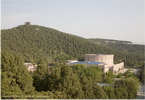 |
Jinan Battle Memorial
济南战役纪念馆 |
|
GPS: |
36.64077,
117.0017 |
|
At the foot of Mount Heroes in
Jinan, a memorial hall
commemorating the battle of
Jinan. It was a battle between
the Kuomintang (KMT) and the
Communist Party of China (CPC)
from September 16 to September
24, 1948 during the Chinese
Civil War. |
|
|
| |
|
|
|
 |
Park - Local life |
|
GPS: |
na |
|
N/A |
|
|
| |
|
|
|
 |
Statue of
Mao Zedong 毛泽东塑像曾 |
|
GPS: |
na |
|
N/A |
|
|
|
|
|
|
 |
Wulongtan Park (Five Dragon
Pool) 五龙潭 |
|
GPS: |
36.66596,
117.01506 |
|
Five-Dragon Pool is also called
"Grey Bay Spring" and is one of
the 72 famous springs. The
Five-Dragon Pool Park takes a
land of 5.44ha. This pool
gathers spring water from five
locations.Five-Dragon Pool is
said to be related to a Shandong
hero Qin Qiong living between
the Sui Dynasty and the Tang
Dynasty. |
|
|
| |
|
|
|
|
LAOSHAN area |
|
|
 |
Huayan temple
华严寺 |
|
GPS: |
36.2055,
120.68113 |
|
The Huayan Temple is the only
Buddhist temple on Mount Lao and
is located on the eastern slope
of the mountain. |
|
|
| |
|
|
|
 |
Mt. Laoshan
崂山 |
|
GPS: |
36.19499,
120.64263 |
|
The entire mountain covers 446
square kilometers and has 218
places of interest, big and
small. It is a famous Taoist
mountain boasting both
mountainous and coastal scenery.
The highest peak of Mt. Laoshan
is the 1,133-meter Jufeng. |
|
|
| |
|
|
|
 |
Laoshan
Taiqing Palace
太清宫 |
|
GPS: |
36.13931,
120.68291 |
The Taiqing Palace, a sacred
Taoist Palace, lies on the
southern slopes of the famous
Mt. Laoshan.
The significant
point of interest about Taiqing
Palace was that it was built in
140 BC during the Western Han
Dynasty (206 BC-24 AD); it is
reputed as the second most
magnificent Taoist building in
China. |
 |
|
|
|
|
|
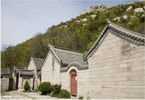 |
Temple (1) |
|
GPS: |
na |
|
N/A |
|
|
| |
|
|
|
 |
Temple (2) |
|
GPS: |
na |
|
N/A |
|
|
| |
|
|
|
|
LIUBU area |
|
|
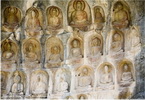 |
1000 Boudhas Cliff
神通寺千佛崖造像 |
|
GPS: |
36.45158,
117.13602 |
|
T. |
|
|
| |
|
|
|
 |
Ceremony at monastery |
|
GPS: |
na |
|
N/A |
|
|
| |
|
|
|
 |
Dragon
and Tiger pagoda
神通寺龙虎塔 |
|
GPS: |
36.45158,
117.13602 |
|
Tiger Pagoda is to the south of
Grave Tower Forest, facing the
Four- Door Pagoda across a
valley. Built in the Tang
dynasty, this pagoda is famous
for the fine sculptures on the
body. |
|
|
|
|
|
|
 |
Four doors pagoda
四门塔 |
|
GPS: |
36.45386,
117.13637 |
|
The pagoda is called the
Four-Door Pagoda because each of
its four sides has a door. Built
in 611 during the Sui Dynasty,
it is the oldest extant
pavilion- style pagoda in China.
The pagoda is built of a kind of
hard stone produced in the area.
It is square, with each side
measuring 7.4 meters long. The
entire pagoda is 10.4 meters
high. |
 |
|
| |
|
|
|
|
|
 |
Little Tang Pagoda 1 and 2 |
|
GPS: |
36.45158,
117.13602 |
|
N/A |
|
|
| |
|
|
|
 |
Monastery of Shentong
神通寺 |
|
GPS: |
36.45075,
117.14353 |
|
Shentong Temple. First built in
351 AD, it is the earliest
Buddhist temple in Shandong. It
had been the center of Buddhism
from East Jin to Sui and Tang
Dynasties. |
|
|
| |
|
|
|
 |
Other
sites |
|
GPS: |
36.45158,
117.13602 |
|
N/A |
|
|
|
|
|
|
 |
Grave Tower Forest |
|
GPS: |
36.45639,
117.1311 |
|
Grave Tower Forest is situated
to the east of the Four Gate
Tower. Consisting of 43 towers,
It used to be the tombs for high
level monks.a |
|
|
| |
|
|
|
|
QINGDAO area |
|
|
 |
Qingdao Christian Church
江苏路基督教堂 |
|
GPS: |
36.06527,
120.32807 |
|
Protestant Church was built by
German missionaries during the
early years of the 20th century
when the German imperialists
forcibly opened China's trading
ports and outrageously occupied
Qingdao, Protestant Church was
designed by the German architect
Curt Rothkegel. |
 |
|
| |
|
|
|
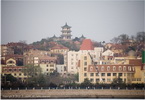 |
Qingdao City
青岛市 |
|
GPS: |
36.07016,
120.36507 |
|
Qingdao, in China’s eastern
Shandong province, is a port
city of skyscrapers, parks and
beaches bordering the Yellow
Sea. It's known for its Tsingtao
Beer, a legacy of the German
occupation (1898-1914), it was
founded by Germans in 1903.
There's also German-style
architecture in the old city
center. |
 |
|
| |
|
|
|
 |
Former
Residence the Pastor of German
Governor 总督牧师宅第旧址 |
|
GPS: |
36.06574,
120.3234 |
|
Built in 1903 at a cost of 2.5
million tears of silver and used
by Mao Zedong in 1958. The
Governor's Mansion has thirty
rooms each with individual
unique fireplaces and distinct
style. |
|
|
|
|
|
|
 |
Huashi Lou (Huashi
Building) 花石楼 |
|
GPS: |
36.05032,
120.35342 |
|
Built in 1930, it originally was
a villa of a Russian aristocrat
and was later sold to a British
businessman. After 1949, the
building was used as a reception
facility. As it is built of
granite and pebbles, it is
called after Huashi Building. |
|
|
| |
|
|
|
|
|
 |
Little Qingdao islet
小青岛 |
|
GPS: |
36.0528,
120.324 |
|
The tiny isle occupies an area
of 0.024 square kilometers, 720
meters from the coast and 17
meters high above sea level. The
local residents called it "The
Small Qingdao Island". This
Island was originally a part of
the mainland. Over the years the
erosion by the sea gradually
isolated the island from the
mainland. |
 |
|
| |
|
|
|
 |
Qingdao Seaside |
|
GPS: |
na |
|
N/A |
|
|
| |
|
|
|
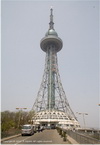 |
Qingdao
TV Tower
青岛电视塔 |
|
GPS: |
36.06819,
120.35786 |
|
The 232 meters Qingdao TV Tower
is the highest tourist
attraction of Qingdao which
offers visitors a spectacular
point to view the whole city and
beautiful blue sea off Qingdao,
the tower can launch 11 sets of
radio and television program. |
|
|
|
|
|
|
 |
Wusi square
五四广场 |
|
GPS: |
36.06209,
120.38498 |
|
May Fourth Square is composed of
Shizhengting Square, the central
square and the coastal park.
Named after the nationwide
protest May Fourth Movement that
started in Qingdao, the square
is best recognized by the large
"May Wind" sculpture near the
seaside. |
|
|
| |
|
|
|
 |
Xinhaoshan park |
|
GPS: |
36.06604,
120.33202 |
|
XinHaoShan (Signal Hill) was
once a signaling station during
the German occupation in 1897.
This hill offers 360° panoramic
views of Old Qingdao and
includes many scenic spots. |
|
|
| |
|
|
|
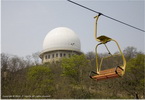 |
Zhongshan park 中山公园 |
|
GPS: |
36.06438,
120.34851 |
|
The park was built in 1901 and
renamed in 1929. It has around
100,000 plants and more than 300
species of plants including
Kentucky coffee trees, oak
trees, medicinal magnolia barks
and some foreign species that
are rare in China. |
 |
|
| |
|
|
|
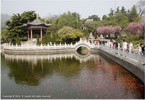 |
Zhanshan
temple
湛山寺 |
|
GPS: |
36.06489,
120.36394 |
|
ZhanShan Temple in 1945. The
monastery has five halls and a
pagoda, with a total area of
20,000 square meters. The temple
boasts a large collection of
skillfully carved statues of
Buddha and Buddhist scriptures. |
 |
|
|
|
|
|
 |
Zhanqiao pier
青岛栈桥 |
|
GPS: |
36.05845,
120.32049 |
|
Zhanqiao pier is at the southern
shore of Qingdao off Zhongshan
Road. This now 440 metres long
strip stretches into the sea and
was the first wharf at Qingdao.
An octagonal pavilion called the
Billowing Back and Forth Tower,
loosely translated, stands at
the end of the pier and was
constructed in 1930. |
 |
|
| |
|
|
|
|
|
QUFU area |
|
|
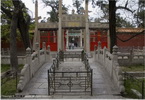 |
Confusius temple
孔庙 |
|
GPS: |
35.59187,
116.99011 |
|
Qufu Confucius Temple (Kong Miao
in Chinese), at the hometown of
Confucius, is the most famous
and the largest temple of its
kind in the memory of the sage.
His ideology was developed to
the influential Confucianism. |
 |
|
| |
|
|
|
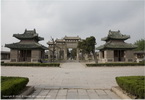 |
Cemetery of Confucius
孔林 |
|
GPS: |
35.61373,
116.9944 |
|
The Cemetery of Confucius lies
to the north of the town of
Qufu. The oldest graves found in
this location date back to the
Zhou Dynasty. The original tomb
erected here in memory of
Confucius on the bank of the
Sishui River had the shape of an
axe. |
 |
|
| |
|
|
|
 |
Qufu City
Walls and Gates |
|
GPS: |
35.59649,
117.0001 |
|
N/A |
|
|
|
|
|
|
 |
Horse Carriage |
|
GPS: |
na |
|
N/A |
|
|
| |
|
|
|
|
|
 |
Kong Family Mansion
孔府 |
|
GPS: |
35.59634,
116.99151 |
|
The direct descendants of
Confucius lived in the Kong
family Mansion located to the
east of the temple. They were in
charge of tending to the temple
and cemetery. The first mansion
was built in 1038 during the
Song dynasty and was originally
connected directly to the
temple. |
 |
|
| |
|
|
|
|
TAIAN area |
|
|
 |
Tai an City
泰安市 |
|
GPS: |
36.20025,
117.08761 |
|
Tai'an is a noted tourist city.
Although Taishan Mountain is the
most celebrated of its
attractions, other scenic spots
are also well worth a visit. |
 |
|
| |
|
|
|
 |
Dai Temple 岱庙 |
|
GPS: |
36.19401,
117.13122 |
|
The majestic Dai Temple was
first built in Han Dynasty
(202B.C-220A.D) and became
glorious in Tang Dynasty
(618-907). And when it came to
Zhenzong Period (968-1022) of
Song Dynasty, the temple was
enlarged. The style follows that
of imperial palace, boasting one
hundred and fifty architectures
in total. |
 |
|
| |
|
|
|
 |
Tai Shan
泰山 |
|
GPS: |
36.25583,
117.10555 |
The leader of the 'Five Sacred
Mountains' is lying across the
cities of Tai'an, Jinan and
Zibo. Its main peak, Jade
Emperor Summit is about 1532.7
meters (5,029 feet) high.
The
mountain was once called Mt.
Daishan, Mt. Daizong or Mt.
Taiyue and was renamed Mt.
Taishan in the Spring and Autumn
Period (770BC-476BC). It
epitomizes splendid Chinese
culture and was listed in the
World Natural and Cultural
Heritage List of UNESCO in 1987. |

 |
|
|
|
|
|
|
OTHERS |
|
|
 |
Shandong Seaside |
|
GPS: |
na |
|
N/A |
|
|
| |
|
|
|
|
|
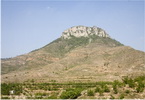 |
Others |
|
GPS: |
na |
|
N/A |
|
|
| |
|
|
|






















































